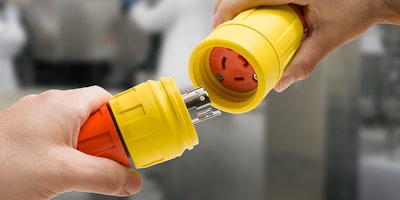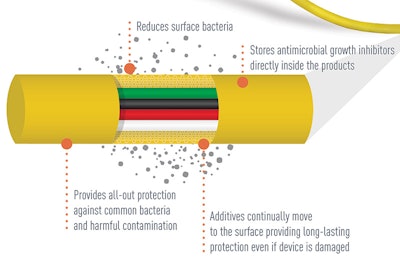
 Jeff Seabury
Jeff SeaburyFoodborne contamination in food and beverage processing plants results in losses of $10 million per year on average. What’s worse is the 43 million illnesses, 128,000 hospitalizations and 3,000 deaths that occur each year from foodborne contamination.
Providing antimicrobial protection on electrical wiring devices, cords, cables and connectors is key to preventing the growth of harmful microorganisms, like E. coli, staphylococcus, listeria, and salmonella. Standard mandatory safety protocols alone, such as chemical washdowns, can’t guarantee reliable and enduring protection.
Antimicrobial protection makes a surface undesirable for microbial population. So when microorganisms appear on the surface of a protected wiring device, antimicrobial compounds make contact with them and disrupt their ability to live and multiply.
One method of antimicrobial protection is to apply a spray or a dip directly to the surface of the material you are trying to protect, such as wires, cables and connectors. Another method that is still relatively new to the industry is to install electrical wires and connectors with antimicrobial protection embedded on the outer and inner surfaces.
Embedded Antimicrobial Protection Inside and Out
Unlike sprays and dips, electrical cords and components with embedded antimicrobial protection store antimicrobial growth inhibitors directly inside the products themselves, providing protection on the inner and outer surfaces. Those additives are gradually released to the surface, providing continuous, long-lasting protection against the growth of bacteria, molds, mildews and fungi.
Since the protection is embedded throughout the product, the antimicrobial solution will still work at full strength and will even deliver more protection from the inner to the outer surface in the presence of a physical cut or abrasion. The protection is not subject to wearing out over time.
Embedded antimicrobial protection is a solid option for food and beverage processing plants because of its ability to stand up to the harsh environment. While sprays and dips can be effective, they have a hard time standing up to the kind of environment that is seen at meat processing plants or other processing facilities with frequent washdowns.
With sprays and dips, there is an inconsistency in performance because there is usually an inconsistency in application. Electrical wiring products with embedded antimicrobial protection, however, have been tested and are proven to hold up consistently. Research shows that wiring with embedded antimicrobial protection reduces the amount of E. coli, Salmonella, Staphylococcus and Listeria by over 99 percent.

When to Use Antimicrobial Sprays and Dips
An antimicrobial spray or dip, although it only protects the outer surface of the material you apply it to, can still be effective. There are some situations where a food and beverage processing facility should choose a spray over embedded protection.
Most facilities will use an antimicrobial spray to clean the outside and the inside of an animal carcass before they start processing, or they will use a spray to wash down the equipment at the end of the day. Those are a few situations where embedded protection isn’t beneficial, and a spray should be used.
Since they are used in a harsh environment in a food and beverage facility, sprays and dips are subject to wearing out over time. Cords and connectors on the floor of a food processing plant are prone to cuts and abrasions. Since sprays and dips are only applied to the outer surface of the material, a cut or abrasion leaves the inner surface unprotected against the growth of microorganisms.
In some cases, it may be possible to reapply the antimicrobial spray or dip. But because it’s fluxing over time, it will lose effectiveness again, and the cable will ultimately need to be replaced.
Added Value in Cost Savings
The use of embedded antimicrobial protection has been met with a degree of skepticism—with many questioning if it’s truly worth the value. There is a cost difference associated with the use of embedded antimicrobial protection. For example, an extra-hard use plug or connector that is normally in the $10 range might jump to $25 or $30 for producers, or even more for end users.
It’s important to remember though that a disease outbreak or a product recall can bankrupt your company or cost millions of dollars. The average cost of a recall for a food processing company is $10 million with additional losses due to brand damage and reduced sales, according to a joint study by the Food Marketing Institute and the Grocery Manufacturers Association.
Since the protection with embedded antimicrobial products is continuous and not subject to wearing out over time, there is an added cost benefit of not having to replace cords, cables and connectors as often.
A Low-Cost Solution to FSMA regulations
To combat foodborne pathogens, the FDA introduced the Food Safety Modernization Act (FSMA), which requires all food and beverage facilities to have a Hazard Analysis and Risk-Based Preventative Controls (HARPC) Plan, to improve the food safety program and cut down on illnesses.
Ensuring a large, fast-paced food or beverage facility meets the FSMA requirements can feel like a daunting task. Turning to innovative, low-cost solutions, like installing wiring systems with embedded antimicrobial protection, empowers your facility to meet FSMA standards and cut down on foodborne pathogens.
The Best Option for the F&B Processing Industry
Wiring with embedded antimicrobial protection is the best option for standing up to the harsh environment within a food and beverage processing plant. They inhibit the growth of microorganisms by creating an environment that is not conducive to their growth. Over time, microorganisms will be reduced to a level that can no longer be measured by standard laboratory equipment.
Research and independent testing show that embedded antimicrobial protection delivers continuous and long-lasting benefits to manufacturers beyond traditional cleaning methods, such as a standard washdown.
Jeff Seabury is Industrial Product Manager at Legrand.




















